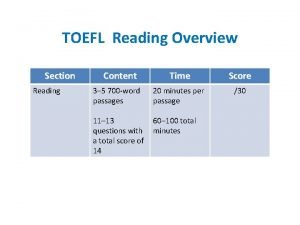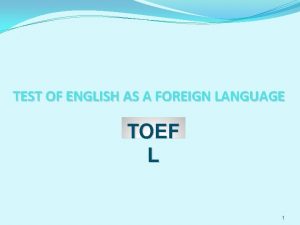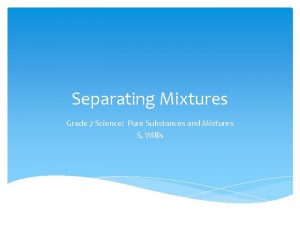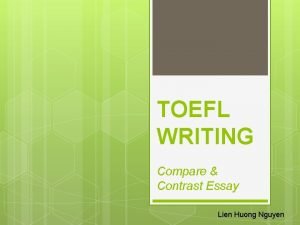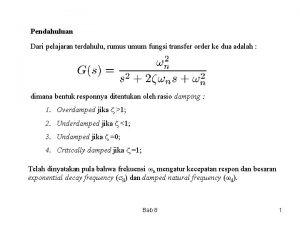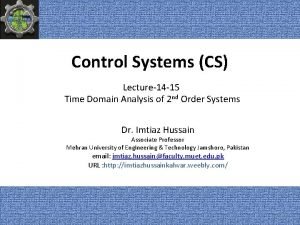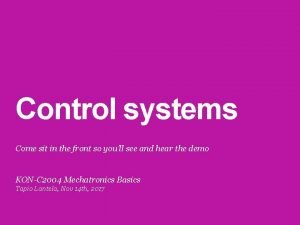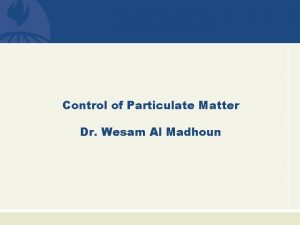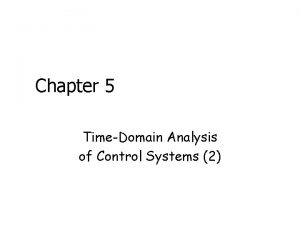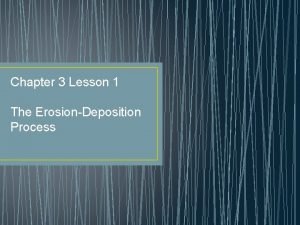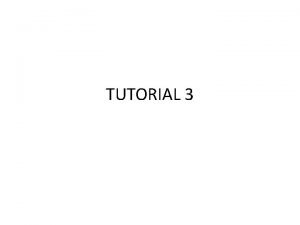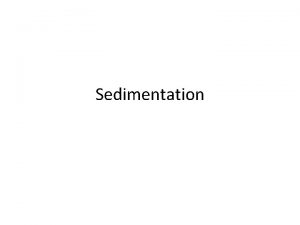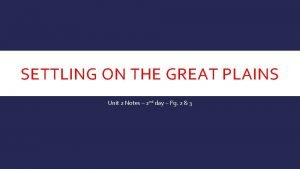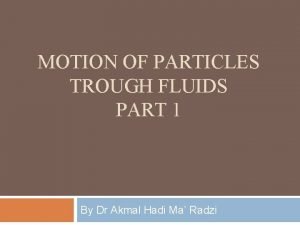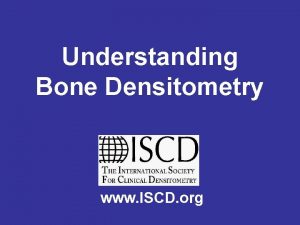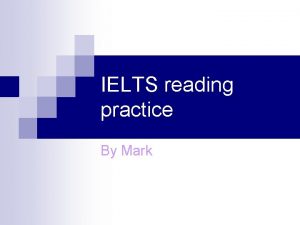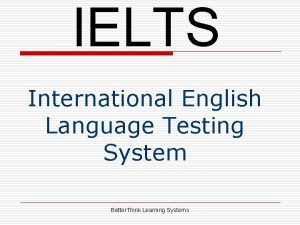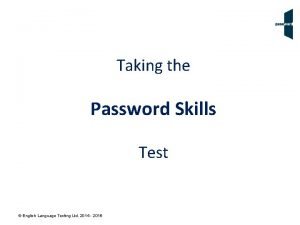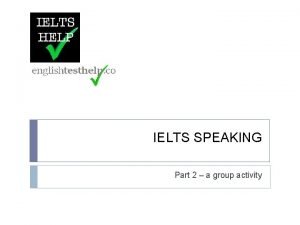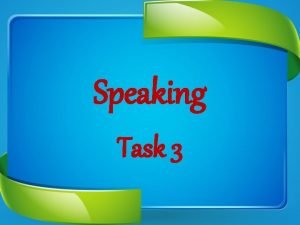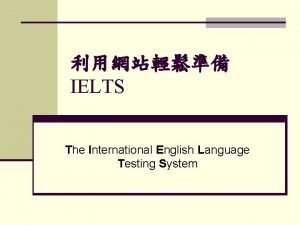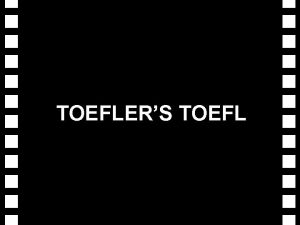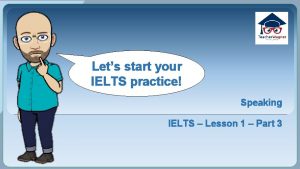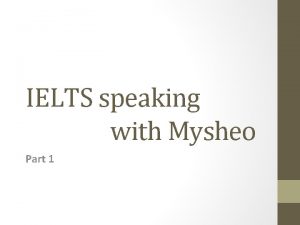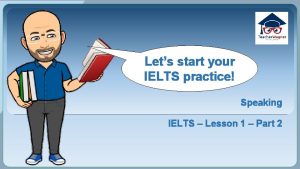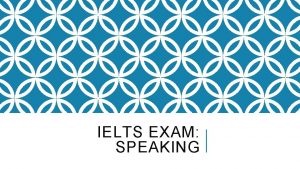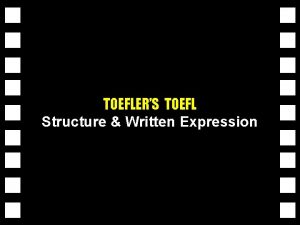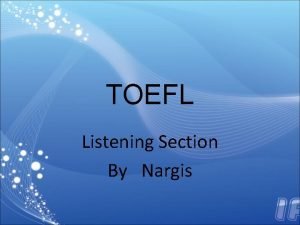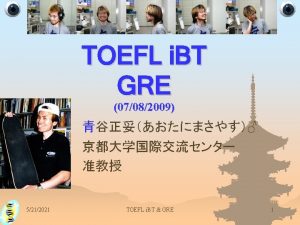SETTLING THE SCORE Comparing IELTS and TOEFL i



















































- Slides: 51

SETTLING THE SCORE: Comparing IELTS and TOEFL i. BT score gains in an international undergraduate conditional admissions program Reese M. Heitner, Ph. D rmh 54@drexel. edu DREXEL UNIVERSITY English Language Center Copyright Reese M. Heitner March 2015. All Rights Reserved.

Settling the Score: Comparing IELTS and TOEFL i. BT score gains in an international undergraduate conditional admissions program I. AY 2011 -2012 INTERNATIONAL GATEWAY PROGRAM A. B. C. D. E. Program Design Program Participants Program Outcomes Historical Enrollment and Retention Rates Research Questions II. ASSESSMENT A. B. C. D. E. F. English Language Proficiency 1. IEP level placement 2. IEP level progression 3. Standardized examination 4. Relationship between IEP placement levels and entry scores University Courses 1. Gateway Co. AS performance 2. Relationship between Gateway Co. AS GPAs and entry scores Standardized Test Progress 1. Composite score gains across intervals 2. Composite score gains by subgroups 3. Score gains by module Repeat Test-Taking: Estimating an i. BT Familiarity Effect Matriculated University Performance Comparison among Gateway Matriculated GPAs and Direct Admission GPAs III. CONCLUSIONS A. B. Research Answers 1. Concurrent validity 2. Predictive validity 3. Score gains 4. Familiarity effect References Copyright Reese M. Heitner March 2015. All Rights Reserved.

Settling the Score: Comparing IELTS and TOEFL i. BT score gains in an international undergraduate conditional admissions program I. THE INTERNATIONAL GATEWAY PROGRAM A. Program Design Table 1 AY 2011 -2012 Gateway Curriculum English Language/ Communication Skills (hours/week) Term 1 Fall 2011 Term 2 Winter 2012 Term 3 Spring 2012 Term 4 Summer 2012 15 hours ELC Oral (L/S) Communication Written (R/W) Communication 7. 5 hours ELC Foundations of Academic Writing (CHEM support) 10. 5 hours ELC Skills for College Success Oral (L/S) Communication Co. AS Credit Courses Math placement test MATH (3 -4) credits MATH (3 -4 credits) CHEM (3 credits) MATH (3 -4 credits) PHIL (3 credits) Test Preparation (hours/week) 6 hours IELTS/i. BT preparation 3 hours IELTS/i. BT preparation or Skills for College Success End of Term Benchmark IELTS 5. 0 i. BT 53 IELTS i. BT 5. 5 62 ELC University Support Advising December 2011 IELTS i. BT 6. 0 70 Advising Math Resource Center March 2012 IELTS i. BT 6. 0 73 June 2012 IELTS i. BT 6. 5 79 August 2012 Copyright Reese M. Heitner March 2015. All Rights Reserved.

Settling the Score: Comparing IELTS and TOEFL i. BT score gains in an international undergraduate conditional admissions program I. THE INTERNATIONAL GATEWAY PROGRAM B. Program Participants Copyright Reese M. Heitner March 2015. All Rights Reserved.

Settling the Score: Comparing IELTS and TOEFL i. BT score gains in an international undergraduate conditional admissions program I. THE INTERNATIONAL GATEWAY PROGRAM C. Program Outcomes Copyright Reese M. Heitner March 2015. All Rights Reserved.

Settling the Score: Comparing IELTS and TOEFL i. BT score gains in an international undergraduate conditional admissions program I. THE INTERNATIONAL GATEWAY PROGRAM D. Historical Enrollment and Retention Rates Table 2 Gateway Student Enrollment and Retention 2009 -2014 PRE-MATRICULATION ACADEMIC YEAR DREXEL ENROLLMENT RETENTION (returning for 2 nd year) Kuwait Saudi Arabia 2010 -2011 5 3 China Columbia Saudi Arabia 2011 -2012 32 30 China Saudi Arabia Taiwan China Japan Korea Oman Thailand China Japan Venezuela 2012 -2013 56 54 2013 -2014 45 45 2014 -2015 42 Available September 2015 -2016 Available 43 -50 August 2015 Available September 2016 COHORT GATEWAY YEAR GATEWAY ENROLLMENT COUNTRIES OF ORIGIN Pilot 2009 -2010 6 Cohort I 2010 -2011 44 Cohort II 2011 -2012 95 Cohort III 2012 -2013 74 Cohort IV 2013 -2014 72 Cohort V 2014 -2015 75 71 Copyright Reese M. Heitner March 2015. All Rights Reserved.

Settling the Score: Comparing IELTS and TOEFL i. BT score gains in an international undergraduate conditional admissions program I. THE INTERNATIONAL GATEWAY PROGRAM E. Research Questions 1. 2. 3. 4. What is the relationship between measurements of English language proficiency and standardized IELTS and i. BT scores? CONCURRENT VALIDITY What is the relationship between standardized IELTS and i. BT scores and GPA performance? PREDICTIVE VALIDITY What is the quantity and rate of IELTS and i. BT score gains across multiple testing intervals and the relative balance among modules? SCORE GAINS What is the i. BT score-gain effect of repeat test-taking—merely sitting for the test again? FAMILIARITY EFFECT Copyright Reese M. Heitner March 2015. All Rights Reserved.

Settling the Score: Comparing IELTS and TOEFL i. BT score gains in an international undergraduate conditional admissions program II. ASSESSMENT A. English Language Proficiency 1. IEP level placement Figure 4 Copyright Reese M. Heitner March 2015. All Rights Reserved.

Settling the Score: Comparing IELTS and TOEFL i. BT score gains in an international undergraduate conditional admissions program II. ASSESSMENT A. English Language Proficiency 2. IEP level progression Figure 5 Copyright Reese M. Heitner March 2015. All Rights Reserved.

Settling the Score: Comparing IELTS and TOEFL i. BT score gains in an international undergraduate conditional admissions program II. ASSESSMENT A. English Language Proficiency 2. IEP level progression Figure 6 Copyright Reese M. Heitner March 2015. All Rights Reserved.

Settling the Score: Comparing IELTS and TOEFL i. BT score gains in an international undergraduate conditional admissions program II. ASSESSMENT A. English Language Proficiency 2. IEP level progression Table 3 AY 2011 -2012 Average placement and rates of IEP progression in Listening/Speaking (L/S) and Reading/Writing (R/W) in levels 1 -6 Full cohort (n = 91) Matriculated (n = 56) Dismissed (n = 24) Transferred (n = 5) Withdrew (n = 6) Average L/S level Fall 2011 Average L/S level Winter 2012 Average rate of L/S progression Average R/W level Fall 2011 Average R/W level Winter 2012 Average rate of R/W progression 3. 16 4. 12 0. 96 2. 82 3. 69 0. 87 3. 41 4. 38 0. 97 2. 93 3. 89 0. 96 2. 71 3. 63 0. 92 2. 63 3. 29 0. 66 3. 80 4. 80 1. 00 2. 80 3. 80 1. 00 2. 17 3. 17 1. 00 2. 67 3. 33 0. 66 Copyright Reese M. Heitner March 2015. All Rights Reserved.

Settling the Score: Comparing IELTS and TOEFL i. BT score gains in an international undergraduate conditional admissions program II. ASSESSMENT A. English Language Proficiency 3. Standardized examination Table 4 AY 2011 -2012 Descriptive statistics of IELTS entry scores grouped by outcome IELTS cohort (n = 41) Matriculated (n = 17) Dismissed (n = 14) Transferred (n = 6) Withdrew (n = 4) Mean Median Mode Range Standard deviation 4. 98 5. 0 4. 5— 6. 5 . 386 5. 12 5. 0 4. 5— 5. 5 . 332 4. 82 5. 0 4. 5— 5. 0 . 316 5. 0 4. 5— 6. 0 . 516 4. 62 4. 5— 5. 0 . 250 AY 2011 -2012 Descriptive statistics of i. BT entry scores grouped by outcome i. BT cohort (n = 54) Matriculated (n = 39) Dismissed (n = 12) Transferred (n = 1) Withdrew (n = 2) Mean Median Mode Range Standard deviation 59. 74 58. 00 57. 00 49— 82 7. 910 60. 28 59. 00 57. 00 49— 77 7. 272 56. 66 56. 00 49— 73 7. 773 82. 00 0 0 56. 5 56. 00 56— 57 . 707 Copyright Reese M. Heitner March 2015. All Rights Reserved.

Settling the Score: Comparing IELTS and TOEFL i. BT score gains in an international undergraduate conditional admissions program II. ASSESSMENT A. English Language Proficiency nif p<. 05 ica tis tic all y sig NOT nif i nt sta sig tis tic all y Standardized examination Figure 7 sta 3. ca nt p>. 05 Copyright Reese M. Heitner March 2015. All Rights Reserved.

Settling the Score: Comparing IELTS and TOEFL i. BT score gains in an international undergraduate conditional admissions program II. ASSESSMENT A. English Language Proficiency Standardized examination Figure 8 tis tic all y sig NOT nif i sta 3. ca n t p>. 05 Copyright Reese M. Heitner March 2015. All Rights Reserved.

Settling the Score: Comparing IELTS and TOEFL i. BT score gains in an international undergraduate conditional admissions program II. ASSESSMENT A. English Language Proficiency 3. Standardized examination Figure 9 Copyright Reese M. Heitner March 2015. All Rights Reserved.

Settling the Score: Comparing IELTS and TOEFL i. BT score gains in an international undergraduate conditional admissions program II. ASSESSMENT A. English Language Proficiency 3. Standardized examination Figure 10 Copyright Reese M. Heitner March 2015. All Rights Reserved.

Settling the Score: Comparing IELTS and TOEFL i. BT score gains in an international undergraduate conditional admissions program II. ASSESSMENT A. English Language Proficiency 3. Standardized examination Table 5 AY 2011 -2012 IELTS versus i. BT entry score module rankings LOWER HIGHER entry scores IELTS Writing (4. 825) Listening (4. 875) Speaking (5. 10) Reading (5. 15) i. BT Reading (13. 37) Listening (13. 83) Speaking (16. 59) Writing (16. 78) Copyright Reese M. Heitner March 2015. All Rights Reserved.

Settling the Score: Comparing IELTS and TOEFL i. BT score gains in an international undergraduate conditional admissions program II. ASSESSMENT A. English Language Proficiency 4. Relationship between IEP placement levels and entry scores Figure 11 L/S : IELTS R/W : IELTS . 608 . 582 (p <. 01) L/S : R/W . 508 (p <. 01) Copyright Reese M. Heitner March 2015. All Rights Reserved.

Settling the Score: Comparing IELTS and TOEFL i. BT score gains in an international undergraduate conditional admissions program II. ASSESSMENT A. English Language Proficiency 4. Relationship between IEP placement levels and entry scores Figure 12 L/S L/S: : IELTS : i. BT . 238. 325 (p < >. 05) R/W : i. BT L/S : R/W . 171 . 508 (p >. 05) (p <. 01) Copyright Reese M. Heitner March 2015. All Rights Reserved.

Settling the Score: Comparing IELTS and TOEFL i. BT score gains in an international undergraduate conditional admissions program II. ASSESSMENT A. English Language Proficiency 4. Relationship between IEP placement levels and entry scores Figure 13 L/S : LISTENING IELTS r <. 4 (p >. 05) L/S : SPEAKING IELTS . 641 (p <. 01) R/W: READING IELTS R/W: WRITING IELTS r <. 4 (p >. 05) Copyright (p >. 05) Reese M. Heitner March 2015. All Rights Reserved.

Settling the Score: Comparing IELTS and TOEFL i. BT score gains in an international undergraduate conditional admissions program II. ASSESSMENT A. English Language Proficiency 4. Relationship between IEP placement levels and entry scores TA SK S PR O DU CT IV E Figure 14 L/S : LISTENING i. BT r <. 2 (p >. 05) L/S : SPEAKING i. BT . 355 (p <. 05) R/W: READING i. BT r <. 2 (p >. 05) Copyright R/W: WRITING i. BT 451 . (p <. 01) Reese M. Heitner March 2015. All Rights Reserved.

Settling the Score: Comparing IELTS and TOEFL i. BT score gains in an international undergraduate conditional admissions program II. ASSESSMENT B. University Courses 1. Gateway Co. AS performance Figure 15 Copyright Reese M. Heitner March 2015. All Rights Reserved.

Settling the Score: Comparing IELTS and TOEFL i. BT score gains in an international undergraduate conditional admissions program II. ASSESSMENT B. University Courses sign ifica nt lly NOT tica s i t sta ant ific sign ally Gateway Co. AS performance Figure 16 stat istic 1. p<. 01 p>. 05 Copyright Reese M. Heitner March 2015. All Rights Reserved.

Settling the Score: Comparing IELTS and TOEFL i. BT score gains in an international undergraduate conditional admissions program II. ASSESSMENT B. University Courses 2. Relationship between Gateway Co. AS GPAs and entry scores Figure 17 GPA : IELTS r <. 1 (p >. 05) Copyright Reese M. Heitner March 2015. All Rights Reserved.

Settling the Score: Comparing IELTS and TOEFL i. BT score gains in an international undergraduate conditional admissions program II. ASSESSMENT B. University Courses 2. Relationship between Gateway Co. AS GPAs and entry scores Figure 18 GPA : IELTS r <. 1 (p >. 05) Copyright Reese M. Heitner March 2015. All Rights Reserved.

Settling the Score: Comparing IELTS and TOEFL i. BT score gains in an international undergraduate conditional admissions program II. ASSESSMENT C. Standardized Test Progress 1. Composite score gains across intervals Figure 19 . 28 . 23 The grouping of IELTS scores into specific testing intervals resulted in a loss of some data points. The IELTS attrition rate was 15 data points out of 97 (15%). Copyright Reese M. Heitner March 2015. All Rights Reserved.

Settling the Score: Comparing IELTS and TOEFL i. BT score gains in an international undergraduate conditional admissions program II. ASSESSMENT C. Standardized Test Progress 1. Composite score gains across intervals Figure 20 8. 42 8. 59 The grouping of i. BT scores into specific testing intervals resulted in a loss of some data points. The i. BT attrition rate was 47 data points out of 121 (39%). Copyright Reese M. Heitner March 2015. All Rights Reserved.

Settling the Score: Comparing IELTS and TOEFL i. BT score gains in an international undergraduate conditional admissions program II. ASSESSMENT C. Standardized Test Progress 2. Composite score gains by subgroups Figure 21 Copyright Reese M. Heitner March 2015. All Rights Reserved.

Settling the Score: Comparing IELTS and TOEFL i. BT score gains in an international undergraduate conditional admissions program II. ASSESSMENT C. Standardized Test Progress 2. Composite score gains by subgroups Figure 22 Copyright Reese M. Heitner March 2015. All Rights Reserved.

Settling the Score: Comparing IELTS and TOEFL i. BT score gains in an international undergraduate conditional admissions program II. ASSESSMENT C. Standardized Test Progress 3. Score gains by module Figure 23 Copyright Reese M. Heitner March 2015. All Rights Reserved.

Settling the Score: Comparing IELTS and TOEFL i. BT score gains in an international undergraduate conditional admissions program II. ASSESSMENT C. Standardized Test Progress 3. Score gains by module Figure 24 Copyright Reese M. Heitner March 2015. All Rights Reserved.

Settling the Score: Comparing IELTS and TOEFL i. BT score gains in an international undergraduate conditional admissions program II. ASSESSMENT C. Standardized Test Progress 3. Score gains by module Table 6 AY 2011 -2012 IELTS versus i. BT score-gain module rankings IELTS i. BT LOWER HIGHER score gains 1 st 2 nd entry Reading Speaking HIGHER ENTRY entry SCORES LEAD TO 1 st 2 nd SMALLER GAINS Speaking Writing 4 th 3 rd Writing Listening LOWER ENTRY entry SCORES LEAD TO 3 rd 4 th GREATER GAINS Listening Reading entry Copyright entry Reese M. Heitner March 2015. All Rights Reserved.

Settling the Score: Comparing IELTS and TOEFL i. BT score gains in an international undergraduate conditional admissions program II. ASSESSMENT D. Repeat Test-Taking: Estimating an i. BT Familiarity Effect Figure 20 ? Copyright Reese M. Heitner March 2015. All Rights Reserved.

Settling the Score: Comparing IELTS and TOEFL i. BT score gains in an international undergraduate conditional admissions program II. ASSESSMENT D. Repeat Test-Taking: Estimating an i. BT Familiarity Effect Figure 25 n = 121 WEEKS : i. BT GAINS 3. 03 . 532 (p <. 01) Model 1 (Constant) WEEKS Unstandardized Coefficients B Std. Error 3. 030 1. 979. 639. 093 Standardized Coefficients Beta. 532 t Sig. 1. 531 6. 859 . 129. 000 Correlations Zero-order Partial Copyright . 532 Reese M. Heitner Part. 532 Collinearity Statistics Tolerance VIF 1. 000 March 2014. 1. 000 All Rights Reserved.

Settling the Score: Comparing IELTS and TOEFL i. BT score gains in an international undergraduate conditional admissions program II. ASSESSMENT E. Matriculated University Performance Table 7 AY 2011 -2012 Gateway GPA Co. AS Gateway GPA Matriculated Gateway GPA Term Winter 2011 Spring 2012 Summer 2012 CUM GW Fall 2012 Winter 2013 Spring 2013 CUM MAT n GPA 91 2. 71 64 3. 24 12 3. 11 91 2. 64 56 2. 80 56 3. 17 56 3. 16 56 3. 10 Copyright Reese M. Heitner March 2015. All Rights Reserved.

Settling the Score: Comparing IELTS and TOEFL i. BT score gains in an international undergraduate conditional admissions program II. ASSESSMENT F. Comparison among Gateway Matriculated GPAs and Direct Admission GPAs Table 8 AY 2011 -2012 Matriculated Gateway GPA compared to first- and second-year direct admission GPA Direct Term Gateway Direct domestic international 2. 85 2. 80 3. 12 Fall 2012 (n = 424) (n = 56) (n = 2, 636) 2. 88 3. 17 3. 03 Winter 2013 (n = 415) (n = 56) (n = 2, 556) 3. 01 3. 16 3. 05 Spring 2013 (n = 400) (n = 56) (n = 2, 468) CUM 1 st Year 2. 87 3. 10 3. 04 2012 -2013 (n = 424) (n = 56) (n = 2, 640) nd CUM 2 Year 3. 04 3. 18 2013 -2014 (n = 358) (n = 54) (n = 2, 283) > < < < > > > < Copyright Reese M. Heitner March 2015. All Rights Reserved.

Settling the Score: Comparing IELTS and TOEFL i. BT score gains in an international undergraduate conditional admissions program III. CONCLUSIONS A. Research Answers 1. What is the relationship between measurements of English language proficiency and standardized IELTS and i. BT scores? CONCURRENT VALIDITY Correlations between IELTS/i. BT entry scores and IEP placement are variable ranging from statistically significant (p <. 01) highs (r >. 6) to insignificant (p >. 05) lows (r <. 2). High IELTS: r =. 641 (p <. 01) IELTS Speaking entry scores to IEP L/S placement High i. BT r =. 451 (p <. 01) i. BT Writing entry scores to IEP R/W placement Across four exam modules and two IEP placement instruments: IELTS entry scores appear to track IEP placement more closely than i. BT entry scores. Speaking and Writing modules (productive tasks) on both exams match IEP placement more closely than Listening and Reading (receptive tasks). Drexel IEP placement exams are based upon speaking and writing samples. Related research Geranpayeh, A. (1994). Are score comparisons across language proficiency test batteries justified? An IELTS-TOEFL comparability study. Edinburgh Working Papers in Applied Linguistics, 5: 50– 65. Copyright Reese M. Heitner March 2015. All Rights Reserved.

Settling the Score: Comparing IELTS and TOEFL i. BT score gains in an international undergraduate conditional admissions program III. CONCLUSIONS A. Research Answers 1. What is the relationship among IEP progression rates, IELTS and i. BT entry scores, Co. AS GPAs and successful matriculation? CONCURRENT VALIDITY Figure 26 NOT Across several measures, successful Gateway participants are uniformly (and occasionally statistically) superior to their dismissed or withdrawn peers. Related research Bellingham, L. (1993). The relationship of language proficiency to academic success for international students. New Zealand Journal of Educational Studies 30(2): 229 -232. Copyright Reese M. Heitner March 2014. All Rights Reserved.

Settling the Score: Comparing IELTS and TOEFL i. BT score gains in an international undergraduate conditional admissions program III. CONCLUSIONS A. Research Answers 1. What is the relationship between English language proficiency and standardized IELTS and i. BT scores? CONCURRENT VALIDITY IELTS Craven, E. (2012). The quest for IELTS Band 7. 0: Investigating English language proficiency development of international students at an Australian university. IELTS Research Reports, vol. 13: 1 -61. Elder, C. & O’Loughlin, K. (2003). Investigating the relationship between intensive English language study and band score gain on IELTS Research Reports, vol. 4: 207 -241. Ingram, D. & Bayliss, A. (2007). IELTS as a predictor of academic language performance, Part 1. IELTS Research Reports, vol. 7: 137 -191. O’Loughlin, K. & Arkoudis, S. (2009). Investigating IELTS exit score gains in higher education. IELTS Research Reports 10: 95 -180. Paul, A. (2007). IELTS as a predictor of academic language performance: Part 2. IELTS Research Reports, vol. 7: 205 -240. i. BT Ling, G. , Powers, D. & Adler, R. (2014). Do TOEFL i. BT Scores Reflect Improvement in English-Language Proficiency? Extending the TOEFL i. BT Validity Argument. ETS Research Report, RR-14 -09. Princeton, NJ: ETS. Copyright Reese M. Heitner March 2015. All Rights Reserved.

Settling the Score: Comparing IELTS and TOEFL i. BT score gains in an international undergraduate conditional admissions program III. CONCLUSIONS A. Research Answers 2. What is the relationship between standardized IELTS and i. BT scores and GPA performance? PREDICTIVE VALIDITY Co. AS GPAs issued during the program do not correlate with IELTS and i. BT entry scores. Unlike increasing IELTS and i. BT scores, Co. AS GPAs do not (and should not be expected) to increase on a term-by-term basis. Both dynamics deflate correlations between standardized IELTS and i. BT scores and Co. AS GPAs. Moreover, neither entry scores nor rates of score gain correlate with postprogram GPAs. This suggests that once a minimal threshold of linguistic proficiency has been achieved. GPAs reflect mastery of course content (and other factors)—not language skills. Copyright Reese M. Heitner March 2015. All Rights Reserved.

Settling the Score: Comparing IELTS and TOEFL i. BT score gains in an international undergraduate conditional admissions program III. CONCLUSIONS A. Research Answers 2. How do first-year and second-year post-Gateway matriculated students compare against directly admitted students in terms of GPAs? PREDICTIVE VALIDITY Figure 27 AY 2012 -2013/2013 -2014 Comparative GPAs 4 3 2 1 0 International direct Gateway Domestic direct All 1 st term 2, 85 2, 8 3, 12 3, 08 2 nd term 2, 88 3, 17 3, 03 3, 01 3 rd term 3, 01 3, 16 3, 05 CUM 1 st Year 2, 87 3, 1 3, 04 3, 01 CUM 2 nd Year 3, 04 3, 18 3, 16 Gateway alumni often exhibit a slight (but not statistically significant) edge over direct peers. Copyright Reese M. Heitner March 2015. All Rights Reserved.

Settling the Score: Comparing IELTS and TOEFL i. BT score gains in an international undergraduate conditional admissions program III. CONCLUSIONS A. Research Answers 2. How do first-year and second-year post-Gateway matriculated students compare against directly admitted students in terms of GPAs? PREDICTIVE VALIDITY IELTS Cotton, F. & Conrow, F. (1998). An investigation of the predictive validity of IELTS amongst a sample of international students studying at the University of Tasmania. IELTS Research Reports, vol. 1: 72 -115. Dooey, P. & Oliver, R. (2002). An investigation into the predictive validity of the IELTS test as an indicator of future academic success. Prospect 17(1), 36‐ 54. Humphreys, P. , Haugh, M. , Fenton-Smith, B. , Lobo, A. , Michael, R. & Walkenshaw, I. (2012). Tracking international students’ English proficiency over the first semester of undergraduate study. IELTS Online Series 2012/1. Kerstjens, M & Nery, C. (2000). Predictive validity in the IELTS test: A study of the relationship between IELTS scores and students’ subsequent academic performance. IELTS Research Reports, vol. 3: 85 -108. i. BT Cho, Y. & Bridgeman, B. (2012). Relationship of TOEFL i. BT scores to academic performance: Some evidence from American universities. Language Testing 29(3), 421 -442. BOTH Arcuino, C. (2013). The Relationship between the Test of English as a Foreign Language (TOEFL), the International English Language Testing System (IELTS) Scores and Academic Success of International Master’s Students. Unpublished dissertation. Colorado State University, Fort Collins, Colorado. Hill, K. , Storch, N. , & Lynch, B. (1999). A comparison of IELTS and TOEFL as predictors of academic success. IELTS Research Reports, vol. 2: 53 -63. Copyright Reese M. Heitner March 2015. All Rights Reserved.

Settling the Score: Comparing IELTS and TOEFL i. BT score gains in an international undergraduate conditional admissions program III. CONCLUSIONS A. Research Answers 3. What is the quantity and rate of IELTS and i. BT score gains across multiple testing intervals and the relative balance among modules? SCORE GAINS IELTS: i. BT: . 32 to. 23 points (12 ± 2 week period) 10. 57 to 8. 42 points (12 ± 2 week period) Longer intervals predictably produce higher score gains, but higher scores produce leveling effects. Bear in mind the SEM values for these tests: 0. 23 for IELTS (2013, www. ielts. org) 5. 64 for i. BT TOEFL (2011, www. ets. org) This means that there is only a 68% chance IELTS scores are accurate within 0. 23 points and i. BT scores within 5. 64 points. Estimates of IEP hours of study to score gains are rough extrapolations. IEP progression: approaches 1 level/11 -week term Extrapolation: IELTS: ≈ 1 point/3 terms i. BT: ≈ 30 points/3 terms Hours/points: IELTS: ≈ 600 contact hours/1 point i. BT: ≈ 600 contact hours/30 points Copyright Reese M. Heitner March 2015. All Rights Reserved.

Settling the Score: Comparing IELTS and TOEFL i. BT score gains in an international undergraduate conditional admissions program III. CONCLUSIONS A. Research Answers 3. What is the quantity and rate of IELTS and i. BT score gains across multiple testing intervals and the relative balance among modules? SCORE GAINS IELTS: . 32 to. 23 points (12 ± 2 week period) Table 9 IELTS Average Score Gains Score gain n Interval Gateway AY 2011 -2012 . 32 34 ≈ 3 months Heitner, Hoekje & Braciszewski (2014) (Gateway AY 2010 -2011) . 35 32 ≈ 3 months Craven (2012) . 30 40 ≈ 19 to 36 months Elder & O’Loughlin (2003) . 598 112 ≈ 3 months Green (2004) (only Writing) . 29 3, 052 at least 3 months Green (2004) (only Writing) . 37 15, 380 at least 3 months Humphreys, et al. (2012) . 107 51 ≈ 4 months O’Loughlin & Arkoudis (2009) . 413 63 ≈ 12 to 36 months Read & Hayes (2003) (excluding Speaking) . 36 17 1 month Copyright Reese M. Heitner March 2015. All Rights Reserved.

Settling the Score: Comparing IELTS and TOEFL i. BT score gains in an international undergraduate conditional admissions program III. CONCLUSIONS A. Research Answers 3. What is the quantity and rate of IELTS and i. BT score gains across multiple testing intervals and the relative balance among modules? SCORE GAINS i. BT: 10. 57 to 8. 42 points (12 ± 2 week period) Table 10 i. BT Average Score Gains Score gain n Interval 25. 78 35 ≈ 9 months China 12. 19 90 9 months USA 23. 11 21 9 months Gateway AY 2011 -2012 Ling, Powers & Adler (2014) For pre-i. BT (pre-2005) TOEFL score-gain research, see Wilson, K. (1987). Patterns of test taking and score change for examinees who repeat the Test of English as a Foreign Language. TOEFL research report #22. Princeton, NJ: Educational Testing Service. Des Brisay, M. , and Ready, D. (1995). Defining an appropriate role for language tests in intensive English programs. In A. Srainee (Ed. ). Issues in language program evaluation in the 1990 s. Anthology series 27. Singapore: Southeast Asian Regional Language Center. Copyright Reese M. Heitner March 2015. All Rights Reserved.

Settling the Score: Comparing IELTS and TOEFL i. BT score gains in an international undergraduate conditional admissions program III. CONCLUSIONS A. Research Answers 3. What is the quantity and rate of IELTS and i. BT score gains across multiple testing intervals and the relative balance among modules? SCORE GAINS Table 11 IELTS and i. BT score gain module rankings LOWER IE LT S i. B T HIGHER GW AY 2011 -2012 Reading Speaking Writing Listening GW AY 2010 -2011 Reading Listening Writing Speaking Craven (2012) Writing Speaking Listening Reading Elder & O’Loughlin (2003) Reading Speaking Writing Listening Humphreys, et al. 2012) Listening Writing Reading Speaking O’Loughlin & Arkoudis (2009) Writing Speaking Listening Reading GW AY 2011 -2012 Speaking Writing Listening Reading Ling, Powers & Adler (2014) China Speaking Writing Listening Reading Ling, Powers & Adler (2014) USA Listening Reading Speaking Writing Norton (2011) Speaking Listening Writing Reading Zhang (2008) Speaking Writing Listening Reading Copyright Reese M. Heitner March 2014. All Rights Reserved.

Settling the Score: Comparing IELTS and TOEFL i. BT score gains in an international undergraduate conditional admissions program III. CONCLUSIONS A. Research Answers 3. What is the quantity and rate of IELTS and i. BT score gains across multiple testing intervals and the relative balance among modules? SCORE GAINS Among IELTS modules, no clear patterns of language advancement. In particular, no obvious distinction between receptive skills (Listening and Writing) and productive skills (Writing and Speaking). However, among i. BT modules, Reading appears to be a leading indicator and Speaking a lagging indicator. Stricker & Attali (2010) report candidates rate i. BT Speaking least favorably. Why? Perhaps because the Speaking test is not a human conversation? But causality is not obvious: Disfavorability may be the result of receiving lower score gains, or lower score gains may be the result of disfavorable attitudes. Or perhaps something about the module is responsible for both lower favorability and lower score gains. Related research Suryaningsih, H. (2014). Students' perceptions of International English Language Testing System (IELTS) and Test of English as a Foreign Language (TOEFL) tests. Unpublished master’s thesis. Indiana University of Pennsylvania, Indiana, Pennsylvania. Score gains are inversely related to entry scores. Copyright Reese M. Heitner March 2015. All Rights Reserved.

Settling the Score: Comparing IELTS and TOEFL i. BT score gains in an international undergraduate conditional admissions program III. CONCLUSIONS A. Research Answers 4. What is the i. BT score-gain effect of repeat test-taking—merely sitting for the test again? FAMILIARITY EFFECT As should be expected, there is a quantifiable i. BT familiarity effect. 3. 03 “free” points for merely retaking the i. BT exam, comparable to other findings. Table 12 Average short-term i. BT score gains AY 2011 -2012 Zhang (2008) Norton (2011) Score gain 3. 03 3. 74 4. 36 n 121 12, 000 25 Interval 0 days within 30 days Copyright Reese M. Heitner March 2015. All Rights Reserved.

Settling the Score: Comparing IELTS and TOEFL i. BT score gains in an international undergraduate conditional admissions program III. CONCLUSIONS A. Research Answers 4. What is the i. BT score-gain effect of repeat test-taking—merely sitting for the test again? FAMILIARITY EFFECT Both Zhang (2008) and Norton (2011) were short-interval “stability studies. ” The latter designed “to reduce as far as possible the effect of a real increase in language skill” (Norton 2011, p. 36). Given a measurable familiarity effect, should “test-wiseness” be discouraged? Should the effects of test experience be discounted? Consider that test experience can improve rather than undermine validity. As argued by Messick (1996), repeat test-taking can more accurately reveal true language abilities—by reducing the novelty of the test and the anxiety of the testtaker. Repeat test-taking can, in this way, be a factor increasing—not an artifact decreasing—test validity. Related research Kokhan & Lin (2014) review repeat test-taking score-gain research relative to i. BT TOEFL and other standardized exams (e. g. , SAT, LSAT, MCAT). Copyright Reese M. Heitner March 2015. All Rights Reserved.

Settling the Score: Comparing IELTS and TOEFL i. BT score gains in an international undergraduate conditional admissions program III. CONCLUSIONS B. References Arcuino, C. (2013). The Relationship between the Test of English as a Foreign Language (TOEFL), the International English Language Testing System (IELTS) Scores and Academic Success of International Master’s Students. Unpublished dissertation. Colorado State University, Fort Collins, Colorado. Bellingham, L. (1993). The relationship of language proficiency to academic success for international students. New Zealand Journal of Educational Studies 30(2): 229 -232. Cho, Y. & Bridgeman, B. (2012). Relationship of TOEFL i. BT scores to academic performance: Some evidence from American universities. Language Testing 29(3), 421 -442. Cotton, F. & Conrow, F. (1998). An investigation of the predictive validity of IELTS amongst a sample of international students studying at the University of Tasmania. IELTS Research Reports, vol. 1: 72 -115. Craven, E. (2012). The quest for IELTS Band 7. 0: Investigating English language proficiency development of international students at an Australian university. IELTS Research Reports, vol. 13: 1 -61. Des Brisay, M. , and Ready, D. (1995). Defining an appropriate role for language tests in intensive English programs. In A. Srainee (Ed. ). Issues in language program evaluation in the 1990 s. Anthology series 27. Singapore: Southeast Asian Regional Language Center. Dooey, P. & Oliver, R. (2002). An investigation into the predictive validity of the IELTS test as an indicator of future academic success. Prospect 17(1), 36‐ 54. Elder, C. & O’Loughlin, K. (2003). Investigating the relationship between intensive English language study and band score gain on IELTS Research Reports, vol. 4: 207 -241. Geranpayeh, A. (1994). Are score comparisons across language proficiency test batteries justified? : An IELTS-TOEFL comparability study. Edinburgh Working Papers in Applied Linguistics 5: 50– 65. Green, A. (2004). Making the grade: Score gains on the IELTS writing test. IELTS Research Notes 16: 9 -13. Heitner, R. , Hoekje, B. & Braciszewski, P. (2014). Keys to College: IELTS Score Gains among International Students in an Undergraduate Conditional Admission Program. In J. Connor-Linton and L. Amoroso (Eds. ), Georgetown University Round Table on Languages and Linguistics 2012: Measured Language: Quantitative Approaches to Acquisition, Assessment, Processing and Variation. Washington, DC: Georgetown University Press. Hill, K. , Storch, N. , & Lynch, B. (1999). A comparison of IELTS and TOEFL as predictors of academic success. IELTS Research Reports, vol. 2: 53 -63. Humphreys, P. , Haugh, M. , Fenton-Smith, B. , Lobo, A. , Michael, R. & Walkenshaw, I. (2012). Tracking international students’ English proficiency over the first semester of undergraduate study. IELTS Online Series 2012/1. Ingram, D. & Bayliss, A. (2007). IELTS as a predictor of academic language performance, Part 1. IELTS Research Reports, vol. 7: 137 -191. Kerstjens, M & Nery, C. (2000). Predictive validity in the IELTS test: A study of the relationship between IELTS scores and students’ subsequent academic performance. IELTS Research Reports, vol. 3: 85 -108. Kokhan, K. & Lin, C. (2014). Test of English as a Foreign Language (TOEFL): Interpretation of multiple score reports for ESL placement. Papers in Language Testing and Assessment, vol. 3(1): 1 -23. Ling, G. , Powers, D. & Adler, R. (2014). Do TOEFL i. BT Scores Reflect Improvement in English-Language Proficiency? Extending the TOEFL i. BT Validity Argument. ETS Research Report, RR-14 -09. Princeton, NJ: ETS. Norton, D. (2011). Exploring discrepancies in the i. BT scores of repeat test takers. Doshisha Women's College of Liberal Arts Academic Research Annual Report 62: 35 -41. O’Loughlin, K. & Arkoudis, S. (2009). Investigating IELTS exit score gains in higher education. IELTS Research Reports 10: 95 -180. Paul, A. (2007). IELTS as a predictor of academic language performance: Part 2. IELTS Research Reports, vol. 7: 205 -240. Read, J. & Hayes, B. (2003). The impact of the IELTS test on preparation for academic study in New Zealand. IELTS Research Reports, vol. 4: 153 -206. Stricker, L. & Attali, Y. (2010). Test takers’ attitudes about the i. BT Research Report, TOEFLi. BT-1, RR-10 -02. Suryaningsih, H. (2014). Students' perceptions of International English Language Testing System (IELTS) and Test of English as a Foreign Language (TOEFL) tests. Unpublished master’s thesis. Indiana University of Pennsylvania, Indiana, Pennsylvania. Wilson, K. (1987). Patterns of test taking and score change for examinees who repeat the Test of English as a Foreign Language. TOEFL Research Report #22. Princeton, NJ: Educational Testing Service. Zhang, Y. (2008). Repeater analyses for i. BT. ETS Research Memorandum. RM-08 -05. Copyright Reese M. Heitner March 2015. All Rights Reserved.

SETTLING THE SCORE: Comparing IELTS and TOEFL i. BT score gains in an international undergraduate conditional admissions program Reese M. Heitner, Ph. D rmh 54@drexel. edu DREXEL UNIVERSITY English Language Center Copyright Reese M. Heitner March 2015. All Rights Reserved.
 Www.ielts.org
Www.ielts.org Timescore
Timescore What is toef
What is toef Flotation and settling
Flotation and settling How to separate mechanical mixtures
How to separate mechanical mixtures T-score statistics
T-score statistics Unit 8 fashion and design ielts answers
Unit 8 fashion and design ielts answers Writing advantages and disadvantages essay structure
Writing advantages and disadvantages essay structure Skill 24 adjectives and adverbs
Skill 24 adjectives and adverbs Toefl itp level
Toefl itp level Compare and contrast conclusion example
Compare and contrast conclusion example Primary settling
Primary settling Hazen formula for settling velocity
Hazen formula for settling velocity Settling velocity stokes law
Settling velocity stokes law Differential settling method
Differential settling method Rumus fungsi transfer
Rumus fungsi transfer Gravitational settling chamber
Gravitational settling chamber Detention time in sedimentation tank
Detention time in sedimentation tank Fcs underdamped graph
Fcs underdamped graph Settling time control system
Settling time control system Wesam al madhoun
Wesam al madhoun First order system equation
First order system equation Lesson outline the erosion-deposition process answer key
Lesson outline the erosion-deposition process answer key Gravitational settling chamber
Gravitational settling chamber Settling types
Settling types Settling velocity
Settling velocity An ideal horizontal flow settling basin
An ideal horizontal flow settling basin Settling on the great plains section 2
Settling on the great plains section 2 Chapter 4 settling disputes
Chapter 4 settling disputes Soddie
Soddie What is late charge in front office
What is late charge in front office Settling jamestown
Settling jamestown Settling the west part 2 packet- farming the plains
Settling the west part 2 packet- farming the plains Define terminal settling velocity
Define terminal settling velocity Calculating overshoot
Calculating overshoot What is iscd
What is iscd Q scores meaning
Q scores meaning Ielts abbreviation
Ielts abbreviation Ielts test scores
Ielts test scores Advice ielts speaking part 3
Advice ielts speaking part 3 Ielts reading introduction
Ielts reading introduction Better think ielts
Better think ielts Ielts org results
Ielts org results Password test speaking sample
Password test speaking sample Mail @ ielts-kku.info
Mail @ ielts-kku.info Speaking ielts topics
Speaking ielts topics Ace the ielts
Ace the ielts Jeff puccini
Jeff puccini Task 3 speaking
Task 3 speaking Pembersihan karang gigi
Pembersihan karang gigi Glipmpse
Glipmpse Ielts exam net reading
Ielts exam net reading

